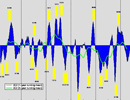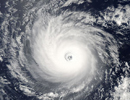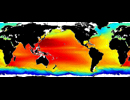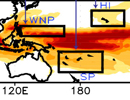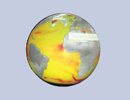Global Distributions of High-wind Occurrence
0.25x0.25 degree QuikSCAT wind data from August 1999 are used to
calculate the frequency of high sea winds stronger than 20 m/s.
(Source of Wind Data: Remote Sensing Systems www.ssmi.com)
Observations are twice daily at the maximum, only over the ocean. The data contaminated by
rain or sea ice were removed before calculation.
The number of valid observations varies with place and season. So an appropriate measure of
occurrence of high winds would be the percentage of high winds in total valid wind observations.
If you use GrADS, for example, the percentage is expressed as
100 * hw20 / maskout(hw00,hw00-18)
where hw20 is # of wind observations stronger than 20 m/s and hw00 is # of total valid observations.
'maskout' is used to mask grids where # of total valid observations is too small (<18,
i.e., <30% of the maximum in monthly data).
This work is supported by NASA (National Aeronautics and Space Administration) and JAMSTEC (Japan Agency for Marine-Earth Science and Technology).
Reference
Sampe, T., and S.-P. Xie, 2007: "Mapping high sea winds from space: A global climatology" Bull. Amer. Meteor. Soc., 88, pp.1965-1978.
Abstract (AMS Journals Online)
pdf (AMS Journals Online; ~6.9MB)
| Variables | # days of valid data, #days of wind speed >= 20 m/s, #days of wind speed >= 25 m/s, #days of wind speed >= 30 m/s, mean zonal & meridional wind of valid data, mean zonal & meridional wind w/ wind speed >= 20 m/s, mean zonal & meridional wind w/ wind speed >=25 m/s, mean zonal & meridional wind w/ wind speed >=30 m/s |
| Zonal | Global by 0.25 deg |
| Meridional | Global by 0.25 deg |
| Vertical | 10-m height |
| Temporal | Aug 1999 to Dec 2006 by 1 month(s) |
| Static? | yes |
| Volume | 597mb/year |
| Server | public:      |
| Source | http://apdrc.soest.hawaii.edu/projects/highwind |
| Acquired | May 30, 2008 |
| APDRC contact | |
| Supplements | See Takeaki Sampe or Shang Ping Xie regarding analysis |



